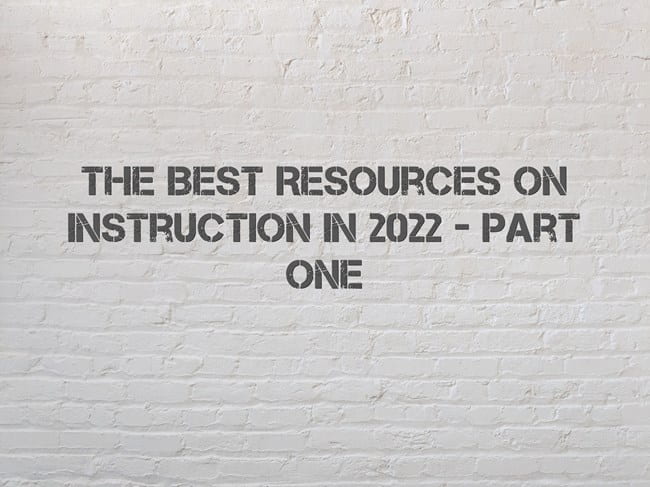I’m continuing with my mid-year “Best” list posts…
Seven years ago I began publishing a regular Classroom Instruction Resources Of The Week post. You can see all my “Best” lists on instructional strategies here.
Here are my choices from the past few months:
THE DIFFERENCES BETWEEN “RITUALS” & “ROUTINES” IN THE CLASSROOM, & WHY WE NEED BOTH
MY 8 END-OF-SCHOOL-YEAR REFLECTION POSTS – ALL IN ONE PLACE
Don’t Confuse Reading Comprehension and Learning to Read — Rereading is by Timothy Shanahan. Though he only talks about it at the end, it’s not possible to over-emphasize the need to have different clear purposes laid-out for rereadings (for example, in my History class, it’s to develop questions that might be on the test). I’m adding it to The Best Resources On “Close Reading” — Help Me Find More.
How to Build an Affirming Classroom in the Face of Anti-Trans Legislation is from Facing History. I’m adding it to THE BEST WAYS TO SUPPORT LGBTQ STUDENTS.
WHAT IS INTERLEAVING, AND WHY DOES IT WORK? is from Inner Drive.
What Should Culturally Relevant Teaching Look Like Today? Gloria Ladson-Billings Explains is from Ed Week. I’m adding it to the same list.
8 Principles for Supporting Students with ADHD is from Cult of Pedagogy. I’m adding it to THE BEST RESOURCES FOR LEARNING ABOUT ADHD.
Retrieval Practice: One Minute to Better Student Learning is from ASCD. I’m adding it to The Best Resources For Learning About Retrieval Practice.
Rebound: Turning Our Attention to Acceleration appeared in Language Magazine. I’m adding it to THE BEST RESOURCES ABOUT ACCELERATED LEARNING.
I’ve often posted about Quill as a great tool for ELLs and English-proficient students to develop better grammar skills. They’ve now created a new tool called Quill Reading For Evidence that uses Artificial Intelligence to support both more sophisticated reading and writing. I like it a lot. I signed-up to use it this year during its pilot phase. I’m assuming it will be made available to everyone soon – if it hasn’t already.
How Educators Around the World Are Teaching the Russia-Ukraine War is from The NY Times Learning Network. I’m adding it to THE BEST TEACHING & LEARNING RESOURCES ABOUT THE RUSSIA/UKRAINE WAR.
Integrating Literacy Instruction with Science and Social Studies is by Timothy Shanahan.
Ron Ritchhart offers some great Project Zero related infographics. I’m adding them to PROJECT ZERO’S “THINKING ROUTINES TOOL” IS AN EXCELLENT RESOURCE.
One-Pagers: Teaching Summaries by Jamie Clark are really impressive, and well-designed, one page summaries of key instructional strategies. I’m adding it to The Best Collections Of Instructional Strategies.
3 Steps to Better Peer Feedback is from Edutopia. I’m adding it to The Best Ideas On Peer Review Of Student Writing.
Touchable Earth has lots of lessons from around the world that appear to be, in many ways, actually taught in video by children from those country. I’m adding it to The Best Sites For Learning About The World’s Different Cultures.
What We Say and How We Say It is from Language Magazine. I’m adding it to THE BEST RESOURCES SHARING RECOMMENDATIONS ABOUT “TEACHER TALK”
How to Make Math Concepts Feel Relevant to Students is from Edutopia. I’m adding it to The Best Apps, Online Tools & Other Resources For Math.
Why do we convince ourselves that students are misbehaving on purpose? is from Chalkbeat. I’m adding it to Best Posts On Classroom Management.
What is self-explanation and how does it work? is from TES. I’m adding it to The Best Resources For Learning About The Value Of “Self-Explanation”
Looking at Data Through an Equity Lens comes from ASCD Educational Leadership. I like what the authors say about looking through a “asset-based perspective” lens, which is similar to the “improvement rubric” concept I talk about in some links at The Best Rubric Sites (And A Beginning Discussion About Their Use). I’m adding this info to The Best Posts On Looking At Our Students Through The Lens Of Assets & Not Deficits and to The Best Resources Showing Why We Need To Be “Data-Informed” & Not “Data-Driven”
Teaching controversial issues when democracy is under attack is from Brookings. I’m adding it to The Best Posts & Articles On How To Teach “Controversial” Topics.
Teaching Dilemmas: They Never Go Away is by Larry Cuban. Cuban often does a good job setting up competing challenges teachers face daily and providing more clarity about them. I’ve written about another one he’s written about: A Look Back: The Difference Between “Good” Teaching & “Successful” Teaching – And What This Means For The This School Year. You might also be interested in Why Viewing Classroom Management as a Mystery Can Be a Good Thing.
A Simple, Effective Framework for PBL is from Edutopia. I’m adding it to The Best Sites For Cooperative Learning Ideas.
So Your Student Believes the Earth Is Flat is from Usable Knowledge. I’m adding it to The Best Posts & Articles On How To Teach “Controversial” Topics.
5 STRATEGIES FOR READING COMPLEX TEXTS is from The Confident Teacher. I’m adding it to The Best Posts On Reading Strategies & Comprehension – Help Me Find More!
New Thinking About Student Engagement is from ASCD. I’m adding it to The Best Posts & Articles On Student Engagement.
How to Teach Writing Fluency is by Timothy Shanahan. I’m adding it to Best Posts On Writing Instruction.
This Is How I Am Using The 1619 Project in My Class is from the Education Post. I’m adding it to USEFUL RESOURCES FOR LEARNING ABOUT THE 400TH ANNIVERSARY OF BRINGING ENSLAVED AFRICANS TO AMERICA.
Why some California school districts are changing how students earn grades is from EdSource. I’m adding it to The Best Resources On Grading Practices.
Teaching About Our Climate Crisis: Combining Games and Critical Thinking to Fight Misinformation is from The American Educator. I’m adding it to The Best Tools & Lessons For Teaching Information Literacy – Help Me Find More.
10 Best Plants for the Classroom is from Edutopia.




Recent Comments